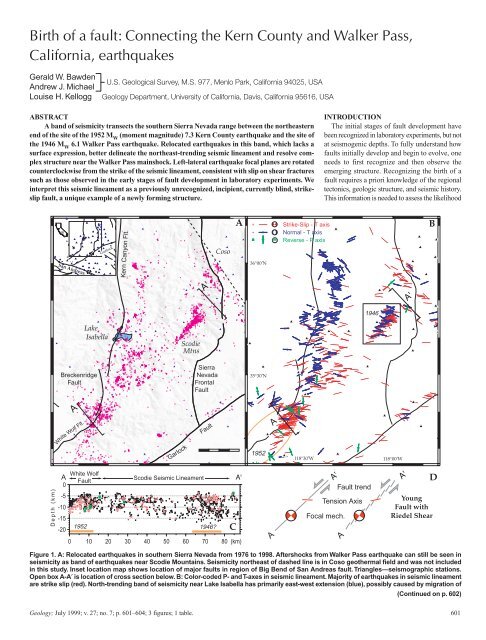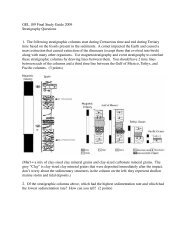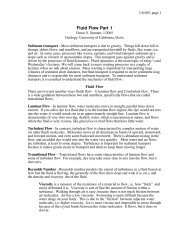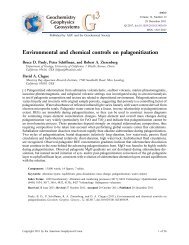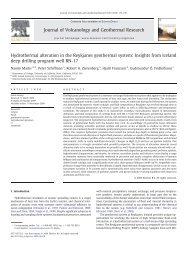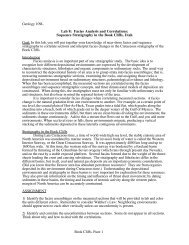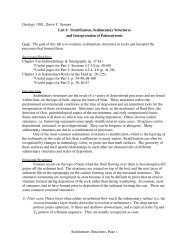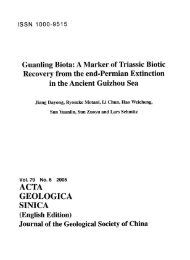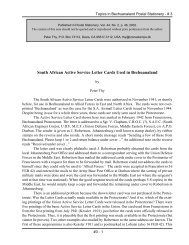Birth of a fault: Connecting the Kern County and Walker ... - Geology
Birth of a fault: Connecting the Kern County and Walker ... - Geology
Birth of a fault: Connecting the Kern County and Walker ... - Geology
You also want an ePaper? Increase the reach of your titles
YUMPU automatically turns print PDFs into web optimized ePapers that Google loves.
<strong>Birth</strong> <strong>of</strong> a <strong>fault</strong>: <strong>Connecting</strong> <strong>the</strong> <strong>Kern</strong> <strong>County</strong> <strong>and</strong> <strong>Walker</strong> Pass,<br />
California, earthquakes<br />
Gerald W. Bawden<br />
Andrew J. Michael<br />
Louise H. Kellogg<br />
U.S. Geological Survey, M.S. 977, Menlo Park, California 94025, USA<br />
<strong>Geology</strong> Department, University <strong>of</strong> California, Davis, California 95616, USA<br />
ABSTRACT<br />
A b<strong>and</strong> <strong>of</strong> seismicity transects <strong>the</strong> sou<strong>the</strong>rn Sierra Nevada range between <strong>the</strong> nor<strong>the</strong>astern<br />
end <strong>of</strong> <strong>the</strong> site <strong>of</strong> <strong>the</strong> 1952 M W<br />
(moment magnitude) 7.3 <strong>Kern</strong> <strong>County</strong> earthquake <strong>and</strong> <strong>the</strong> site <strong>of</strong><br />
<strong>the</strong> 1946 M W<br />
6.1 <strong>Walker</strong> Pass earthquake. Relocated earthquakes in this b<strong>and</strong>, which lacks a<br />
surface expression, better delineate <strong>the</strong> nor<strong>the</strong>ast-trending seismic lineament <strong>and</strong> resolve complex<br />
structure near <strong>the</strong> <strong>Walker</strong> Pass mainshock. Left-lateral earthquake focal planes are rotated<br />
counterclockwise from <strong>the</strong> strike <strong>of</strong> <strong>the</strong> seismic lineament, consistent with slip on shear fractures<br />
such as those observed in <strong>the</strong> early stages <strong>of</strong> <strong>fault</strong> development in laboratory experiments. We<br />
interpret this seismic lineament as a previously unrecognized, incipient, currently blind, strikeslip<br />
<strong>fault</strong>, a unique example <strong>of</strong> a newly forming structure.<br />
INTRODUCTION<br />
The initial stages <strong>of</strong> <strong>fault</strong> development have<br />
been recognized in laboratory experiments, but not<br />
at seismogenic depths. To fully underst<strong>and</strong> how<br />
<strong>fault</strong>s initially develop <strong>and</strong> begin to evolve, one<br />
needs to first recognize <strong>and</strong> <strong>the</strong>n observe <strong>the</strong><br />
emerging structure. Recognizing <strong>the</strong> birth <strong>of</strong> a<br />
<strong>fault</strong> requires a priori knowledge <strong>of</strong> <strong>the</strong> regional<br />
tectonics, geologic structure, <strong>and</strong> seismic history.<br />
This information is needed to assess <strong>the</strong> likelihood<br />
San Andreas<br />
Garlock<br />
<strong>Kern</strong> Canyon Flt.<br />
Coso<br />
A<br />
36°00′N<br />
Strike-Slip - T axis<br />
Normal - T axis<br />
Reverse - P axis<br />
B<br />
1946<br />
Lake<br />
Isabella<br />
Breckenridge<br />
Fault<br />
Scodie<br />
Mtns<br />
Sierra<br />
Nevada<br />
Frontal<br />
Fault<br />
35°30′N<br />
A<br />
White Wolf Flt.<br />
Garlock<br />
Fault<br />
km<br />
0 10 20<br />
1952<br />
A<br />
118°30′W<br />
118°00′W<br />
Depth (km)<br />
A<br />
0<br />
-5<br />
-10<br />
-15<br />
-20<br />
White Wolf<br />
Fault<br />
1952<br />
Scodie Seismic Lineament<br />
1946?<br />
C<br />
Fault trend<br />
Tension Axis<br />
Focal mech.<br />
D<br />
Young<br />
Fault with<br />
Riedel Shear<br />
A<br />
A<br />
0 10 20 30 40 50 60 70 80 (km)<br />
Figure 1. A: Relocated earthquakes in sou<strong>the</strong>rn Sierra Nevada from 1976 to 1998. Aftershocks from <strong>Walker</strong> Pass earthquake can still be seen in<br />
seismicity as b<strong>and</strong> <strong>of</strong> earthquakes near Scodie Mountains. Seismicity nor<strong>the</strong>ast <strong>of</strong> dashed line is in Coso geo<strong>the</strong>rmal field <strong>and</strong> was not included<br />
in this study. Inset location map shows location <strong>of</strong> major <strong>fault</strong>s in region <strong>of</strong> Big Bend <strong>of</strong> San Andreas <strong>fault</strong>. Triangles—seismographic stations.<br />
Open box A-A′ is location <strong>of</strong> cross section below. B: Color-coded P- <strong>and</strong> T-axes in seismic lineament. Majority <strong>of</strong> earthquakes in seismic lineament<br />
are strike slip (red). North-trending b<strong>and</strong> <strong>of</strong> seismicity near Lake Isabella has primarily east-west extension (blue), possibly caused by migration <strong>of</strong><br />
(Continued on p. 602)<br />
<strong>Geology</strong>; July 1999; v. 27; no. 7; p. 601–604; 3 figures; 1 table. 601
that earthquake hypocenters that occur far from<br />
known <strong>fault</strong>s represent new <strong>fault</strong> formation ra<strong>the</strong>r<br />
than slip at depth on existing structures. Fur<strong>the</strong>rmore,<br />
young <strong>fault</strong>s may begin as blind structures,<br />
which makes <strong>the</strong>m difficult to recognize.<br />
The 1983 M W<br />
(moment magnitude) 6.4<br />
Coalinga, 1987 M W<br />
6.0 Whittier Narrows, <strong>and</strong><br />
1994 M W<br />
6.7 Northridge earthquakes revealed<br />
<strong>the</strong> significance <strong>of</strong> blind thrust <strong>fault</strong>s in California.<br />
Unlike <strong>the</strong> San Andreas <strong>fault</strong>, blind <strong>fault</strong>s are<br />
difficult to recognize because <strong>the</strong>y lack visible<br />
surface features. Even after a blind <strong>fault</strong> is identified,<br />
it is difficult to determine whe<strong>the</strong>r <strong>the</strong> <strong>fault</strong><br />
is active (Lettis et al., 1997). However, no active<br />
blind strike-slip <strong>fault</strong>s have been documented<br />
anywhere, with possible exceptions at <strong>the</strong> Long<br />
Valley caldera <strong>and</strong> <strong>the</strong> Mount Lewis seismic<br />
trend in California (Cockerham <strong>and</strong> Pitt, 1984;<br />
Zhou et al., 1993). We present evidence for an incipient,<br />
blind, strike-slip <strong>fault</strong> in California’s<br />
sou<strong>the</strong>rn Sierra Nevada that is associated with <strong>the</strong><br />
1946 <strong>Walker</strong> Pass earthquake.<br />
Figure 1, continued from p. 601.<br />
basin <strong>and</strong> range–style extension into sou<strong>the</strong>rn<br />
Sierra Nevada (Jones <strong>and</strong> Dollar, 1986). Gold<br />
oblate curve surrounding nor<strong>the</strong>rn end <strong>of</strong><br />
White Wolf <strong>fault</strong> is approximate aftershock<br />
zone for 1952 <strong>Kern</strong> <strong>County</strong> earthquake. Box<br />
near A′ is location map for Figure 2. C: A-A′<br />
cross section along Scodie lineament. Symbols<br />
<strong>and</strong> colors represent type <strong>of</strong> earthquake<br />
(see key in B). Black points are earthquakes<br />
that have good locations, uncertain focal<br />
mechanisms. Orange bars represent possible<br />
rupture extent for 1946 <strong>Walker</strong> Pass earthquake<br />
(from aftershock locations) <strong>and</strong> observed<br />
surface rupture from 1952 <strong>Kern</strong> <strong>County</strong><br />
earthquake (Buwalda <strong>and</strong> St. Am<strong>and</strong>, 1955).<br />
D: Schematic diagram <strong>of</strong> T-axis <strong>and</strong> focalmechanism<br />
orientations for well-developed<br />
<strong>fault</strong> <strong>and</strong> <strong>fault</strong> that has Riedel shear. Both<br />
<strong>fault</strong>s are shown with same orientation as<br />
Scodie lineament.<br />
OBSERVATIONS<br />
We studied <strong>the</strong> diffuse b<strong>and</strong> <strong>of</strong> seismicity that<br />
is located between two large, historic, earthquakes:<br />
<strong>the</strong> 1946 M W<br />
6.1 <strong>Walker</strong> Pass earthquake<br />
on <strong>the</strong> nor<strong>the</strong>rn end <strong>of</strong> <strong>the</strong> lineament <strong>and</strong> <strong>the</strong> 1952<br />
M W<br />
7.3 <strong>Kern</strong> <strong>County</strong> earthquake that ruptured<br />
along <strong>the</strong> White Wolf <strong>fault</strong> on <strong>the</strong> sou<strong>the</strong>rn end <strong>of</strong><br />
<strong>the</strong> lineament (hereafter we refer to <strong>the</strong> seismic<br />
lineament as <strong>the</strong> Scodie lineament; Fig. 1). The<br />
idea that <strong>the</strong>se earthquakes were possibly tectonically<br />
connected was loosely suggested by<br />
(Richter, 1958), <strong>and</strong> <strong>the</strong> existence <strong>of</strong> <strong>the</strong> lineament<br />
was observed by Qian et al. (1989). Previous seismicity<br />
studies (Chakrabarty <strong>and</strong> Richter, 1949;<br />
Gardner, 1964) <strong>and</strong> geologic maps (Dibblee <strong>and</strong><br />
Chesterman, 1953; Saleeby <strong>and</strong> Busby-Spera,<br />
1986; Ross, 1989) <strong>of</strong> <strong>the</strong> area do not show a<br />
surface expression <strong>of</strong> a <strong>fault</strong>, geologic structure,<br />
or tectonic l<strong>and</strong>form corresponding to <strong>the</strong> Scodie<br />
lineament. The regional geology is a mix <strong>of</strong><br />
Mesozoic granitic rocks with isolated, northtrending<br />
pre-Cretaceous metamorphic terranes.<br />
The trend <strong>of</strong> <strong>the</strong> lineament is at about a 40° angle<br />
to <strong>the</strong> prominent north-trending fabric <strong>of</strong> <strong>the</strong><br />
Sierra Nevada (Ross, 1986); <strong>the</strong>refore <strong>the</strong> local<br />
geology provides several unambiguous piercing<br />
points along <strong>the</strong> lineament at which displacement<br />
could be resolved.<br />
We relocated <strong>and</strong> calculated focal mechanisms<br />
for <strong>the</strong> earthquakes between <strong>the</strong> nor<strong>the</strong>rn end <strong>of</strong><br />
<strong>the</strong> White Wolf <strong>fault</strong> <strong>and</strong> <strong>the</strong> 1946 main shock.<br />
Both <strong>the</strong> seismic networks in <strong>the</strong> vicinity <strong>of</strong> <strong>the</strong><br />
Scodie lineament <strong>and</strong> <strong>the</strong> techniques used to relocate<br />
earthquakes have significantly improved<br />
since <strong>the</strong> last detailed seismic studies were conducted<br />
for <strong>the</strong> area. The Scodie lineament is on<br />
<strong>the</strong> border between <strong>the</strong> Nor<strong>the</strong>rn <strong>and</strong> Sou<strong>the</strong>rn<br />
California Seismic Networks, <strong>and</strong> both networks<br />
operate seismographic stations in <strong>the</strong> Sierra<br />
Depth (km)<br />
B<br />
0<br />
NW<br />
-5<br />
-10<br />
-15<br />
0 2 4 6<br />
Distance (km)<br />
B'<br />
SE<br />
Strike Slip<br />
Normal<br />
1946<br />
mainshock<br />
Nevada. We took advantage <strong>of</strong> <strong>the</strong> rich data sets<br />
from <strong>the</strong>se overlapping seismic networks by<br />
merging short-period P-wave phase data from<br />
both networks for 7274 earthquakes that occurred<br />
between September 1976 <strong>and</strong> March<br />
1998. To better resolve <strong>the</strong> characteristics <strong>of</strong> <strong>the</strong><br />
seismic lineament, we used <strong>the</strong> method <strong>of</strong> joint<br />
hypocentral determination to obtain new seismic<br />
station traveltime corrections (Kissling, 1988)<br />
<strong>and</strong> <strong>the</strong>n relocated <strong>the</strong> earthquakes (Klein, 1989)<br />
using <strong>the</strong> velocity model derived by Jones <strong>and</strong><br />
Dollar (1986). To minimize erroneous earthquake<br />
locations, we excluded earthquakes that<br />
were recorded at fewer than 15 seismic stations,<br />
had a root-mean-square uncertainty <strong>of</strong> >0.1 s,<br />
had a relative horizontal position uncertainty <strong>of</strong><br />
>0.35 km, <strong>and</strong> a relative vertical position uncertainty<br />
<strong>of</strong> >0.9 km. Similarly, focal mechanisms<br />
B<br />
1946 aftershocks<br />
B'<br />
0 5<br />
km<br />
Figure 2. Focal mechanisms <strong>and</strong> earthquake foci surrounding <strong>Walker</strong> Pass earthquake. This<br />
region contains complex zone <strong>of</strong> left-stepping, left-lateral strike-slip <strong>fault</strong>s <strong>and</strong> <strong>fault</strong> splays with<br />
broadly distributed extensional earthquakes (blue). In cross-section B-B′, main <strong>fault</strong> trace is welldefined<br />
steeply dipping <strong>fault</strong> that begins at about 4 km depth <strong>and</strong> <strong>the</strong>n shallows with increasing<br />
depth. Sou<strong>the</strong>astern <strong>fault</strong> splay on cross section is represented as wide (2 km) zone <strong>of</strong> seismicity<br />
that joins with main <strong>fault</strong>. Because cross section is perpendicular to main <strong>fault</strong>, not to <strong>fault</strong><br />
splay, distribution about <strong>fault</strong> splay is artificially widened.Two focal mechanisms are representative<br />
<strong>of</strong> existing solutions for <strong>Walker</strong> Pass earthquake (Burdick, 1996). Open circles—aftershocks<br />
from 1946 earthquake (Chakrabarty <strong>and</strong> Richter, 1949), yellow star—main shock. Location<br />
shown by box in Figure 1B near Scodie Mountains. Light blue lines are suggested<br />
<strong>fault</strong>-plane locations. Open box labeled B-B′ is location for cross section (inset).<br />
602 GEOLOGY, July 1999
were calculated for all <strong>the</strong> magnitude 2.0 <strong>and</strong><br />
greater earthquakes that had a minimum <strong>of</strong> 12<br />
phase readings (Reasenberg <strong>and</strong> Oppenheimer,<br />
1985). To minimize potential problems with low<br />
amplitude or improper ray traced refracted<br />
waves, we gave lower weight to poor quality<br />
arrivals. All focal mechanisms were visually <strong>and</strong><br />
statistically inspected, <strong>and</strong> unresolveable focal<br />
mechanisms were removed from <strong>the</strong> data set.<br />
The improved hypocenters define a narrower<br />
Scodie seismic lineament (Fig. 1A), with earthquakes<br />
clustered at <strong>the</strong> ends <strong>and</strong> in <strong>the</strong> center <strong>of</strong><br />
<strong>the</strong> lineament. Most earthquakes along <strong>the</strong> Scodie<br />
lineament have strike-slip <strong>fault</strong>-plane solutions,<br />
<strong>and</strong> <strong>the</strong>ir focal depths are greater than 4 km<br />
(Fig. 1, B <strong>and</strong> C). If <strong>the</strong>se earthquakes are aligned<br />
with <strong>the</strong> overall trend <strong>of</strong> <strong>the</strong> seismic lineament,<br />
<strong>the</strong> preferred direction <strong>of</strong> slip would be leftlateral<br />
strike slip along <strong>the</strong> nor<strong>the</strong>ast-striking<br />
<strong>fault</strong> planes (Fig. 2A).<br />
Seismicity in <strong>the</strong> Scodie seismic lineament can<br />
be characterized as three sections (Fig. 1, A–C).<br />
The southwest section contains a mixture <strong>of</strong> leftlateral<br />
strike-slip events <strong>and</strong> reverse events that<br />
are located in <strong>the</strong> aftershock zone <strong>of</strong> <strong>the</strong> 1952<br />
<strong>Kern</strong> <strong>County</strong> earthquake. Most (84%) <strong>of</strong> <strong>the</strong>se<br />
shocks are strike-slip events, presumably leftlateral<br />
slip associated with <strong>the</strong> White Wolf <strong>fault</strong>.<br />
The central region <strong>of</strong> <strong>the</strong> lineament forms a zone<br />
<strong>of</strong> diffuse events with clusters <strong>of</strong> earthquakes<br />
near <strong>the</strong> axis <strong>of</strong> <strong>the</strong> lineament. Nearly all earthquakes<br />
in this section are consistent with leftlateral<br />
strike slip subparallel to <strong>the</strong> lineament.<br />
Earthquakes along <strong>the</strong> nor<strong>the</strong>rn section <strong>of</strong> <strong>the</strong><br />
Scodie lineament are predominately strike-slip<br />
Figure 3. Strike-slip T-axis<br />
orientation histograms for<br />
(A) Scodie seismic lineament<br />
<strong>and</strong> (B) <strong>and</strong> Parkfield<br />
one-dimensional data. Bold<br />
vertical line is expected<br />
T-axis orientation, which is<br />
at 45° from strike <strong>of</strong> <strong>fault</strong>.<br />
Number <strong>of</strong> events<br />
A<br />
60<br />
55<br />
50<br />
45<br />
40<br />
35<br />
30<br />
25<br />
20<br />
15<br />
10<br />
5<br />
0<br />
events with scattered normal-slip events (Fig. 2).<br />
The majority <strong>of</strong> <strong>the</strong> earthquakes in this region are<br />
in <strong>the</strong> vicinity <strong>of</strong> <strong>the</strong> 1946 <strong>Walker</strong> Pass earthquake<br />
<strong>and</strong> suggest a complex series <strong>of</strong> en echelon<br />
<strong>fault</strong> segments. Two such <strong>fault</strong> segments coalesce<br />
at depth as well as along strike (Fig. 2).<br />
The microseismicity in <strong>the</strong> <strong>Walker</strong> Pass earthquake<br />
region suggests that <strong>the</strong> main shock may<br />
have occurred on a nor<strong>the</strong>ast-trending sou<strong>the</strong>astdipping<br />
<strong>fault</strong>, <strong>the</strong>reby helping to constrain <strong>the</strong><br />
variety <strong>of</strong> focal mechanisms that have been calculated<br />
for <strong>the</strong> event. Focal mechanisms for <strong>the</strong><br />
1946 <strong>Walker</strong> Pass earthquake have been calculated<br />
by a variety <strong>of</strong> techniques, all trying to<br />
exploit <strong>the</strong> few available seismic readings<br />
(Chakrabarty <strong>and</strong> Richter, 1949; Dollar <strong>and</strong><br />
Helmberger, 1985; Gardner, 1964; Burdick,<br />
1996). Conclusions from <strong>the</strong>se studies suggest<br />
that <strong>the</strong> main shock occurred on ei<strong>the</strong>r a northtrending<br />
normal <strong>fault</strong> or a nor<strong>the</strong>ast-trending leftlateral<br />
strike-slip <strong>fault</strong> (Fig. 2). On <strong>the</strong> basis <strong>of</strong><br />
trends in <strong>the</strong> microseismicity near <strong>the</strong> main<br />
shock, we favor <strong>the</strong> strike-slip focal mechanism<br />
<strong>and</strong> suggest that <strong>the</strong> nor<strong>the</strong>ast-trending nodal<br />
plane is <strong>the</strong> <strong>fault</strong> plane.<br />
INTERPRETATIONS<br />
On <strong>the</strong> basis <strong>of</strong> <strong>the</strong> seismicity pattern <strong>and</strong> focal<br />
mechanisms, we infer that <strong>the</strong> Scodie lineament<br />
is probably a left-lateral shear zone. Although <strong>the</strong><br />
central section contains only diffuse seismicity,<br />
this could be consistent with an incipient <strong>fault</strong>,<br />
<strong>and</strong> <strong>the</strong> clear activity at both ends should evolve,<br />
with time, toward a connected throughgoing<br />
<strong>fault</strong>. The lack <strong>of</strong> a surface expression associated<br />
250<br />
n = 116 n = 42 n = 257 n = 251<br />
225<br />
Expected<br />
T-axis<br />
orientation<br />
60 80 100 120<br />
T-axis strike (deg)<br />
Number <strong>of</strong> events<br />
B<br />
200<br />
175<br />
150<br />
125<br />
100<br />
75<br />
50<br />
25<br />
0<br />
Expected<br />
T-axis<br />
orientation<br />
80 100 120<br />
T-axis strike (deg)<br />
with <strong>the</strong> seismic lineament may be because it is a<br />
young <strong>fault</strong> that has had little throw.<br />
To determine whe<strong>the</strong>r <strong>the</strong> Scodie lineament is<br />
an incipient feature, we searched for evidence <strong>of</strong><br />
Riedel shear. i.e., <strong>fault</strong>s <strong>and</strong> fractures that form at<br />
an oblique angle (about 10°–35°) to <strong>the</strong> maximum<br />
direction <strong>of</strong> shear in material without a continuous<br />
<strong>fault</strong> surface. In laboratory experiments,<br />
Riedel shear fractures form during <strong>the</strong> early<br />
stages <strong>of</strong> a <strong>fault</strong>’s development, <strong>the</strong> angle between<br />
<strong>the</strong> maximum shear plane <strong>and</strong> <strong>the</strong> Riedel<br />
shear fractures being a function <strong>of</strong> <strong>the</strong> angle <strong>of</strong><br />
internal friction (Bartlett et al., 1981; Schreurs,<br />
1994). For well-developed <strong>fault</strong>s, we would expect<br />
<strong>the</strong> T-axis orientations for earthquakes near<br />
<strong>the</strong> <strong>fault</strong> to be oriented 45° from <strong>the</strong> direction <strong>of</strong><br />
maximum shear. However, if Riedel shear is<br />
present, <strong>the</strong>n we would anticipate as much as a 35°<br />
counterclockwise rotation <strong>of</strong> <strong>the</strong> T-axis orientations<br />
from this expected azimuth (Fig. 1D). For<br />
<strong>the</strong> Scodie lineament, we calculated T-axis azimuths<br />
from strike-slip focal mechanisms that are<br />
within 10 km <strong>of</strong> <strong>the</strong> Scodie lineament <strong>and</strong> found<br />
that <strong>the</strong> majority <strong>of</strong> <strong>the</strong> T-axes are not parallel to<br />
<strong>the</strong> lineament—instead <strong>the</strong>y are rotated counterclockwise<br />
(Figs. 1, B <strong>and</strong> D, <strong>and</strong> 3).<br />
To evaluate <strong>the</strong> significance <strong>of</strong> <strong>the</strong> observed<br />
T-axis rotation within <strong>the</strong> Scodie lineament, we<br />
conducted a statistical test <strong>of</strong> skewness <strong>of</strong> <strong>the</strong><br />
T-axis data about <strong>the</strong> expected T-axis azimuth.<br />
We assume that errors in <strong>the</strong> focal mechanisms<br />
are distributed symmetrically about <strong>the</strong> true<br />
T-axis, an assumption that could be invalid if <strong>the</strong><br />
distribution is not symmetric because <strong>of</strong> poor<br />
station distribution, improperly traced rays, or<br />
noisy data. We binned <strong>the</strong> data into two groups<br />
that contained T-axis trends less than <strong>and</strong> greater<br />
than <strong>the</strong> expected T-axis azimuth. We also truncated<br />
<strong>the</strong> distributions at ±35° from <strong>the</strong> expected<br />
direction. Without Riedel shear, <strong>the</strong> errors should<br />
be symmetric about <strong>the</strong> expected direction (45°<br />
from <strong>the</strong> strike <strong>of</strong> <strong>the</strong> <strong>fault</strong>), so <strong>the</strong> number <strong>of</strong><br />
events in <strong>the</strong> two bins should be described by <strong>the</strong><br />
binomial distribution. In contrast, if Reidel shear<br />
was present, it would show up as skewness in <strong>the</strong><br />
distribution; i.e., <strong>the</strong> number <strong>of</strong> events in ei<strong>the</strong>r<br />
bin is larger than would be found under <strong>the</strong> null<br />
hypo<strong>the</strong>sis <strong>of</strong> no Reidel shear.<br />
We found that <strong>the</strong> observed T-axis orientations<br />
are inconsistent with pure left-lateral slip<br />
along <strong>the</strong> Scodie lineament, but <strong>the</strong>y are consistent<br />
with Riedel shear along <strong>the</strong> lineament<br />
GEOLOGY, July 1999 603
(Fig. 3A, Table 1). The two trends at <strong>the</strong> nor<strong>the</strong>rn<br />
end <strong>of</strong> <strong>the</strong> Scodie lineament (Fig. 2) broaden <strong>the</strong><br />
distribution <strong>of</strong> T-axis azimuths, but are not responsible<br />
for <strong>the</strong> rotation <strong>of</strong> <strong>the</strong> T-axes from <strong>the</strong><br />
expected trend. In contrast, at <strong>the</strong> Parkfield section<br />
<strong>of</strong> <strong>the</strong> San Andreas <strong>fault</strong>, observed T-axis<br />
orientations for strike-slip earthquakes calculated<br />
with both a one-dimensional (Nor<strong>the</strong>rn<br />
California Earthquake Data Center) <strong>and</strong> a threedimensional<br />
seismic velocity model (Eberhart-<br />
Phillips <strong>and</strong> Michael, 1993) are not skewed<br />
(Fig. 3B <strong>and</strong> Table 1), indicating that Reidel<br />
shear is not present on this older, well-developed<br />
<strong>fault</strong>. Because <strong>the</strong> one- <strong>and</strong> three-dimensional<br />
seismic velocity models produced nearly identical<br />
results even though <strong>the</strong> Parkfield region has<br />
significant three-dimensional structure (Eberhart-Phillips<br />
<strong>and</strong> Michael, 1993), we do not expect<br />
that uncertainties in ray tracing affected <strong>the</strong><br />
Scodie lineament results. Thus, at <strong>the</strong> 99.9%<br />
confidence level, <strong>the</strong>re is evidence for Reidel<br />
shear along <strong>the</strong> Scodie lineament. This finding<br />
suggests that <strong>the</strong> Scodie lineament has <strong>the</strong> characteristics<br />
<strong>of</strong> a young, anastomosing <strong>fault</strong> <strong>and</strong><br />
not <strong>of</strong> a continuous structure.<br />
TECTONIC IMPLICATIONS AND<br />
CONCLUSIONS<br />
The close proximity <strong>and</strong> orientations <strong>of</strong> <strong>the</strong><br />
Scodie seismic lineament <strong>and</strong> <strong>the</strong> White Wolf<br />
<strong>fault</strong> suggest that <strong>the</strong>se two structures are related.<br />
The seismic lineament may represent an extension<br />
or propagation <strong>of</strong> <strong>the</strong> White Wolf <strong>fault</strong> toward<br />
<strong>the</strong> nor<strong>the</strong>ast. The Big Bend segment <strong>of</strong> <strong>the</strong><br />
San Andreas <strong>fault</strong> is a restraining bend that is not<br />
oriented parallel to <strong>the</strong> Pacific–North American<br />
plate motion. The White Wolf <strong>and</strong> Garlock <strong>fault</strong>s<br />
both accommodate <strong>the</strong> Big Bend transpression;<br />
oblique reverse slip occurs on <strong>the</strong> White Wolf<br />
<strong>fault</strong>, <strong>and</strong> left-lateral slip occurs on <strong>the</strong> Garlock<br />
<strong>fault</strong> (Fig. 1A, inset). It is possible that <strong>the</strong><br />
Garlock <strong>fault</strong> has shifted south with <strong>the</strong> North<br />
American plate, beyond <strong>the</strong> portion <strong>of</strong> <strong>the</strong> Big<br />
Bend, <strong>the</strong> orientation <strong>of</strong> which deviates <strong>the</strong> most<br />
from <strong>the</strong> Pacific–North American plate motion. If<br />
so, <strong>the</strong>n this kink in <strong>the</strong> San Andreas <strong>fault</strong> might<br />
have caused <strong>the</strong> White Wolf <strong>fault</strong> to leng<strong>the</strong>n to<br />
accommodate fur<strong>the</strong>r slip, extending <strong>the</strong> White<br />
Wolf <strong>fault</strong> to form <strong>the</strong> Scodie seismic lineament.<br />
No older analogues to <strong>the</strong> Scodie seismic lineament<br />
<strong>and</strong> Garlock <strong>fault</strong> are known, perhaps because<br />
<strong>the</strong> Big Bend is not old enough (Atwater<br />
<strong>and</strong> Stock, 1998) to have produced a prior <strong>fault</strong><br />
with a similar orientation.<br />
As discussed here, <strong>the</strong> Scodie lineament may<br />
represent an incipient <strong>fault</strong> that is a product <strong>of</strong> <strong>the</strong><br />
tectonic evolution in <strong>the</strong> Big Bend region. We propose<br />
that <strong>the</strong> diffuse b<strong>and</strong> <strong>of</strong> strike-slip earthquakes<br />
that connects <strong>the</strong> White Wolf <strong>fault</strong> to <strong>the</strong><br />
<strong>Walker</strong> Pass seismicity is an embryonic <strong>fault</strong>. The<br />
15° rotation <strong>of</strong> <strong>the</strong> focal mechanisms from <strong>the</strong><br />
trend <strong>of</strong> <strong>the</strong> lineament is consistent with laboratory<br />
observations <strong>of</strong> <strong>fault</strong> development. Thus we<br />
have extended <strong>the</strong> Riedel shear model from<br />
laboratory-scale experiments to in situ observations<br />
at seismogenic depths.<br />
ACKNOWLEDGMENTS<br />
Support provided by National Science Foundation<br />
grant EAR-97-06690 <strong>and</strong> a Presidential Faculty<br />
Fellowship to Kellogg. We thank R. Stein, C. Jones,<br />
A. Nur, L. Jones, E. Moores, J. Savage, <strong>and</strong> W. Thatcher<br />
for reviews <strong>of</strong> <strong>the</strong> manuscript. We also thank<br />
R. Bürgmann, A. Donnellan, K. Hafner, L. Jones,<br />
D. Oppenheimer, J. Sauber, <strong>and</strong> R. Twiss for comments,<br />
discussions, <strong>and</strong> technical assistance. The seismic<br />
data were obtained through <strong>the</strong> Nor<strong>the</strong>rn California<br />
Earthquake Data Center, a joint project <strong>of</strong> <strong>the</strong> Nor<strong>the</strong>rn<br />
California Seismic Network, U.S. Geological Survey,<br />
Menlo Park, <strong>and</strong> <strong>the</strong> Seismological Laboratory, University<br />
<strong>of</strong> California, Berkeley, <strong>and</strong> through <strong>the</strong> Sou<strong>the</strong>rn<br />
California Seismic Network, a joint project <strong>of</strong> <strong>the</strong><br />
U.S. Geological Survey, Pasadena, <strong>and</strong> <strong>the</strong> Seismological<br />
Laboratory, Pasadena.<br />
REFERENCES CITED<br />
Atwater, T., <strong>and</strong> Stock, J., 1998, Pacific–North America<br />
plate tectonics <strong>of</strong> <strong>the</strong> Neogene southwestern<br />
United States; an update: International <strong>Geology</strong><br />
Review, v. 40, p. 375–402.<br />
Bartlett, W. L., Friedman, M., <strong>and</strong> Logan, J. M., 1981,<br />
Experimental folding <strong>and</strong> <strong>fault</strong>ing <strong>of</strong> rocks under<br />
confining pressure: Part IX. Wrench <strong>fault</strong>s in limestone<br />
layers: Tectonophysics, v. 79, p. 255–277.<br />
Burdick, L. J., 1996, Historical earthquake sequences:<br />
Pasadena, California Institute <strong>of</strong> Technology,<br />
Seismological Laboratory Report, p. 15.<br />
Buwalda, J. P., <strong>and</strong> St. Am<strong>and</strong>, P., 1955, Geological<br />
effects <strong>of</strong> <strong>the</strong> Arvin-Tehachapi earthquake, in<br />
Oakeshott, G., ed., Earthquakes in <strong>Kern</strong> <strong>County</strong>,<br />
California during 1952: California Division <strong>of</strong><br />
Mines Bulletin 171, p. 41–56.<br />
Chakrabarty, S. K., <strong>and</strong> Richter, C. F., 1949, The<br />
<strong>Walker</strong> Pass earthquakes <strong>and</strong> structure <strong>of</strong> <strong>the</strong><br />
sou<strong>the</strong>rn Sierra Nevada: Seismological Society <strong>of</strong><br />
America Bulletin, v. 39, p. 93–107.<br />
Cockerham, R. S., <strong>and</strong> Pitt, A. M., 1984, Seismic activity<br />
in Long Valley caldera area, California; June<br />
1982 through July 1984, in Hill, D., Bailey, R. A.,<br />
<strong>and</strong> Ryall, A. S., eds., Proceedings <strong>of</strong> Workshop<br />
XIX; Active tectonic <strong>and</strong> magmatic processes beneath<br />
Long Valley caldera, eastern California:<br />
U.S. Geological Survey Open-File Report<br />
84-939, p. 493–526.<br />
Dibblee, T. W., Jr., <strong>and</strong> Chesterman, C. W., 1953, <strong>Geology</strong><br />
<strong>of</strong> <strong>the</strong> Breckenridge Mountain quadrangle,<br />
California: California Division <strong>of</strong> Mines <strong>and</strong><br />
<strong>Geology</strong> Bulletin, v. 168, p. 1–56.<br />
Dollar, R. S., <strong>and</strong> Helmberger, D. V., 1985, Body wave<br />
modeling using a master event for <strong>the</strong> sparsely<br />
recorded 1946 <strong>Walker</strong> Pass, California earthquake:<br />
Eos (Transactions, American Geophysical<br />
Union), v. 66, p. 964.<br />
Eberhart-Phillips, D., <strong>and</strong> Michael, A. J., 1993, Threedimensional<br />
velocity structure, seismicity, <strong>and</strong><br />
<strong>fault</strong> structure in <strong>the</strong> Parkfield region, central<br />
California: Journal <strong>of</strong> Geophysical Research,<br />
v. 98, p. 15,737–15,758.<br />
Gardner, J. K., 1964, Earthquakes in <strong>the</strong> <strong>Walker</strong> Pass<br />
region, California, <strong>and</strong> <strong>the</strong>ir relation to <strong>the</strong> tectonics<br />
<strong>of</strong> <strong>the</strong> sou<strong>the</strong>rn Sierra Nevada [Doctoral<br />
<strong>the</strong>sis]: Pasadena, California Institute <strong>of</strong> Technology,<br />
122 p.<br />
Jones, L. M., <strong>and</strong> Dollar, R. S., 1986, Evidence <strong>of</strong> basin<strong>and</strong>-range<br />
extensional tectonics in <strong>the</strong> Sierra<br />
Nevada: The Durrwood Meadows swarm, Tulare<br />
<strong>County</strong>, California (1983–1984): Seismological<br />
Society <strong>of</strong> America Bulletin, v. 76, p. 439–461.<br />
Kissling, E., 1988, Geotomography with local earthquake<br />
data: Reviews <strong>of</strong> Geophysics, v. 26,<br />
p. 659–698.<br />
Klein, F. W., 1989, User’s guide to HYPOINVERSE, a<br />
program for VAX computers to solve for earthquake<br />
locations <strong>and</strong> magnitudes: U.S. Geological<br />
Survey Open-File Report 89-314, p. 58.<br />
Lettis, W. R., Wells, D. L., <strong>and</strong> Baldwin, J. N., 1997,<br />
Empirical observations regarding reverse earthquakes,<br />
blind thrust <strong>fault</strong>s, <strong>and</strong> Quaternary deformation;<br />
are blind thrust <strong>fault</strong>s truly blind?: Seismological<br />
Society <strong>of</strong> America Bulletin, v. 87,<br />
p. 1171–1198.<br />
Qian, H., Jones, C. H., <strong>and</strong> Kanamori, H., 1989, Seismotectonics<br />
<strong>of</strong> <strong>the</strong> sou<strong>the</strong>rn Sierra Nevada, California:<br />
Early stages <strong>of</strong> an intracontinental transform?:<br />
Eos (Transactions, American Geophysical<br />
Union), v. 70, p. 1209.<br />
Reasenberg, P., <strong>and</strong> Oppenheimer, D. H., 1985, FPFIT,<br />
FPPLOT <strong>and</strong> FPPAGE; Fortran computer programs<br />
for calculating <strong>and</strong> displaying earthquake<br />
<strong>fault</strong>-plane solutions: U.S. Geological Survey<br />
Open-File Report 85-739, p. 109.<br />
Richter, C. F., 1958, Elementary seismology: San Francisco,<br />
California, W.H. Freeman <strong>and</strong> Co., Inc.,<br />
768 p.<br />
Ross, D. C., 1986, Basement-rock correlations across<br />
<strong>the</strong> White Wolf–Breckenridge–sou<strong>the</strong>rn <strong>Kern</strong><br />
Canyon <strong>fault</strong> zone, sou<strong>the</strong>rn Sierra Nevada, California:<br />
U.S. Geological Survey Bulletin B1651,<br />
p. 25.<br />
Ross, D. C., 1989, The metamorphic <strong>and</strong> plutonic rocks<br />
<strong>of</strong> <strong>the</strong> sou<strong>the</strong>rnmost Sierra Nevada, California,<br />
<strong>and</strong> <strong>the</strong>ir tectonic framework: U.S. Geological<br />
Pr<strong>of</strong>essional Paper 1381, p. 159.<br />
Saleeby, J. B., <strong>and</strong> Busby-Spera, C., 1986, Stratigraphy<br />
<strong>and</strong> structure <strong>of</strong> metamorphic framework rocks <strong>of</strong><br />
<strong>the</strong> Lake Isabella area, sou<strong>the</strong>rn Sierra Nevada,<br />
California, in Dunne, G. C., ed., Mesozoic <strong>and</strong><br />
Cenozoic structural evolution <strong>of</strong> selected areas,<br />
east-central California: Geological Society <strong>of</strong><br />
America Cordilleran Section Annual Meeting<br />
Field Trip Guidebook, p. 81–94.<br />
Schreurs, G., 1994, Experiments on strike-slip <strong>fault</strong>ing<br />
<strong>and</strong> block rotation: <strong>Geology</strong>, v. 22, p. 567–570.<br />
Zhou, Y., McNally, C., <strong>and</strong> Lay, T., 1993, Analysis <strong>of</strong><br />
<strong>the</strong> 1986 Mt. Lewis, California, earthquake:<br />
Preshock sequence–mainshock–aftershock sequence:<br />
Physics <strong>of</strong> <strong>the</strong> Earth <strong>and</strong> Planetary Interiors,<br />
v. 75, p. 267–288.<br />
Manuscript received December 9, 1998<br />
Revised manuscript received March 16, 1999<br />
Manuscript accepted March 25, 1999<br />
604 Printed in U.S.A. GEOLOGY, July 1999


